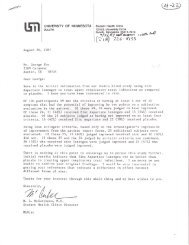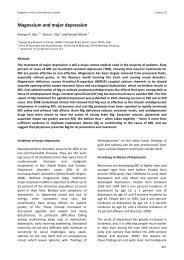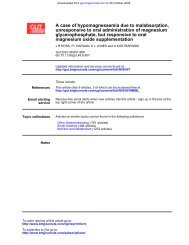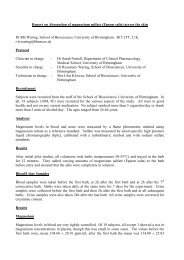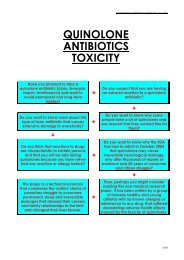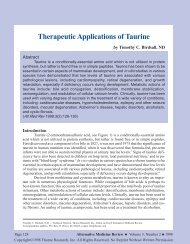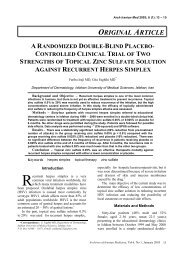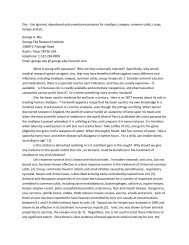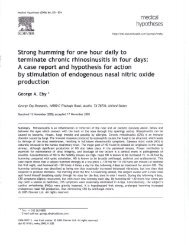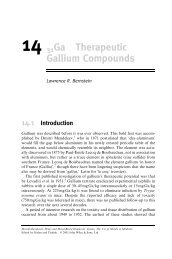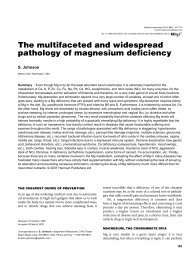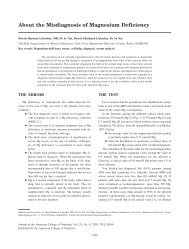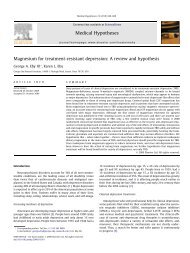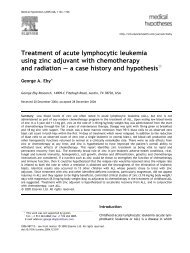10th International Magnesium Symposium Schedule of Events
10th International Magnesium Symposium Schedule of Events
10th International Magnesium Symposium Schedule of Events
You also want an ePaper? Increase the reach of your titles
YUMPU automatically turns print PDFs into web optimized ePapers that Google loves.
19<br />
Investigation <strong>of</strong> intracellular magnesium mobilization pathways in PC12 cells<br />
by simultaneous Mg-Ca fluorescent imaging<br />
Takeshi Kubota 1 , Hirokazu Komatsu 4 , Yutaka Shindo 2 , Kentaro Tokuno 2 , Yoshiichiro<br />
Kitamura 1 , Hiroto Ogawa 3 , Koji Suzuki 4 , and Kotaro Oka 1 , 1 Center for Life Science<br />
and Technology, Keio University, Yokohama, Japan, 2 Department <strong>of</strong> System Design<br />
Engineering, Keio University, Yokohama, Japan, 3 Department <strong>of</strong> Biology, Saitama<br />
Medical School, Saitama, Japan, 4 Department <strong>of</strong> Applied Chemistry, Keio University,<br />
Yokohama, Japan. kubota@bpni.bio.keio.ac.jp<br />
Intracellular Mg2+ concentration shows dynamic change in response to various<br />
extracellular stimuli in excitable cells, and it suggests that the concentration change<br />
plays important roles in intracellular signal transduction. To clarify the role <strong>of</strong><br />
intracellular Mg2+ and Ca2+ during stimulation, we examined the correlation <strong>of</strong> these<br />
divalent cations in PC12 cells by fluorescent imaging techniques. At first, we<br />
developed a novel fluorescent Mg indicator KMG-104 (Ex = 504 nm, Em = 523 nm).<br />
The dissociation constant (Kd) <strong>of</strong> KMG-104 is 3 mM, near to the intracellular Mg2+<br />
concentration (about 1 mM), and not affected by Ca2+ disturbance. PC12 cells were<br />
double-stained by KMG-104 and a Ca2+ indicator, Fura-Red, and the fluorescences<br />
exited at 480 nm from these dyes were acquired simultaneously with a W-View<br />
optical system with a 535/55 BP (KMG-104) and a 600 LP (Fura-Red) filters,<br />
respectively. When the cells were stimulated with a mitochondrial uncoupler, FCCP<br />
(3 µM), both Mg2+ and Ca2+ increased. After washing the FCCP, Mg2+<br />
concentration returned to the basal level, but Ca2+ concentration did not recover. To<br />
investigate the correlation <strong>of</strong> Ca2+ and Mg2+ mobilization directly, intracellular Ca2+<br />
concentration was increased by photolysis <strong>of</strong> caged-Ca2+. Transient increase <strong>of</strong><br />
Ca2+ caused no Mg2+ concentration change. From these results, we presume Mg2+<br />
mobilization pathway does not correspond with Ca2+ cascades. A plausible source<br />
<strong>of</strong> Mg2+ mobilization is Mg2+ release from intracellular Mg-ATP complex by ATP<br />
consumptions.



